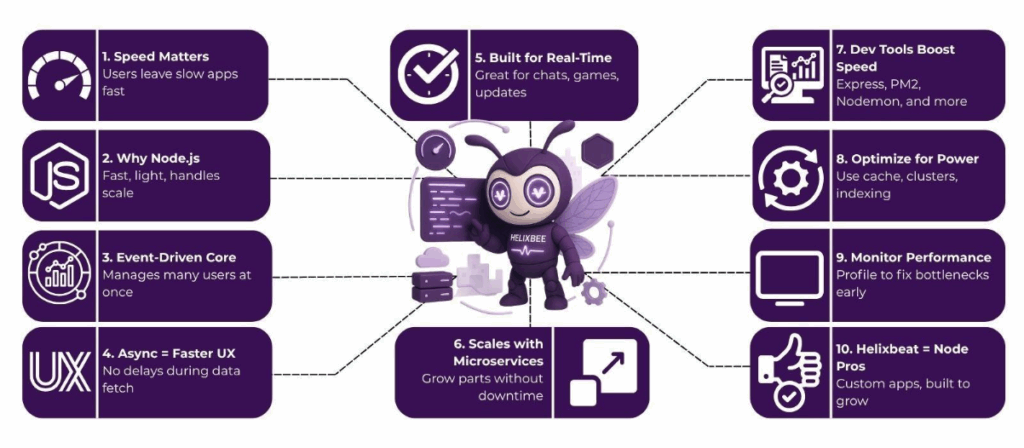As businesses grow, they face the challenge of keeping their web applications fast and reliable, especially as more users come online. Customers expect a smooth, quick experience, and studies show that 47% of users will leave a website if it takes more than 2 seconds to load. That’s a lot of lost opportunities!
This is where Node.js web development can make a real difference. Node.js helps businesses create applications that are both fast and able to handle lots of users at once, without slowing down. With its lightweight and efficient structure, it’s the perfect solution for companies looking to stay ahead and offer the best experience to their customers.
Let’s dive into how Node.js helps businesses build scalable, high-performing web applications that grow with them.

Table of Contents
Evolution of Node.js
Node.js was created in 2009 by Ryan Dahl to solve the problem of handling multiple simultaneous connections in web applications. Initially, it was designed to enable asynchronous event-driven programming in JavaScript, which allowed for non-blocking operations and faster execution. Over the years, its popularity grew rapidly due to its ability to build scalable, real-time applications with high performance.
The introduction of npm (Node Package Manager) further expanded Node.js’s capabilities by providing an ecosystem of reusable libraries and modules. Today, Node.js is widely used by developers across industries for building everything from small startups to large enterprise-level applications, and its vibrant community continues to drive innovation and support for new features and tools.
Benefits of Using Node.js Web Development
Node.js offers several advantages that make it a popular choice for web development. Here are the key benefits:
1. High Performance: Built on the V8 JavaScript engine, Node.js executes code quickly, making it ideal for performance-critical applications.
2. Scalability: Its non-blocking, event-driven architecture allows Node.js to handle a large number of simultaneous connections, making it perfect for scalable applications.
3. Real-Time Data Handling: Node.js excels at real-time applications like chat apps and live updates, providing instant data exchange between server and client.
4. Single Language for Frontend and Backend: Node.js allows developers to use JavaScript for both the server-side and client-side code, streamlining the development process.
5. Large Ecosystem: With npm, Node.js offers access to a vast collection of libraries and tools, which speeds up development and reduces the need to build functionality from scratch.
How Node.js Helps You Create Fast and Scalable Web Applications
Node.js has become a top choice for building fast and scalable web applications, thanks to its unique features and architecture. Here’s how it works:
1. Non-blocking, Event-driven Architecture
Node.js uses a non-blocking, event-driven architecture, which means it doesn’t wait for operations (like reading files or fetching data from a database) to finish before moving on to the next task. This ensures faster execution and better handling of multiple tasks simultaneously.
- Can process multiple requests at once without waiting.
- Increases application throughput by reducing waiting time.
- Ideal for applications that need to handle high volumes of data and user requests.
2. Single-threaded Event Loop
Instead of spawning multiple threads to handle requests, Node.js operates on a single thread with an event loop that manages all the requests. This minimizes the overhead and improves performance by efficiently managing resources.
- Reduces the need for complex multi-threading.
- Ensures less memory consumption.
- Handles hundreds or thousands of simultaneous requests efficiently.
3. Asynchronous Data Handling
Node.js’s ability to perform asynchronous operations is one of its biggest strengths. It allows the server to initiate tasks like data fetching or file reading and move on to other tasks without waiting for these operations to complete, which boosts performance.
- Improves application speed by allowing concurrent operations.
- Minimizes delays in data fetching and processing.
- Optimizes user experience with quick load times.
4. Built-in Tools for Real-time Applications
Node.js is ideal for building real-time web applications like live chats, gaming apps, and streaming services. Its architecture supports real-time, bidirectional communication between clients and servers, ensuring smooth, low-latency experiences.
- Supports WebSockets for real-time communication.
- Enables fast data exchange between client and server.
- Perfect for applications requiring instant updates, like stock trading apps or messaging platforms.
5. Efficient Scaling with Microservices
Node.js is a great fit for microservices architectures. It allows developers to build lightweight, independent services that can easily be scaled and deployed separately. This flexibility ensures applications can grow without losing performance.
- Easily scales components based on traffic.
- Supports horizontal scaling across multiple servers.
- Makes it simple to update and maintain individual services without affecting the entire application.
By leveraging these features, Node.js helps developers build web applications that are not only fast but also scalable, able to handle high traffic loads, and flexible for future growth.
7 Popular Tools for Scalable Node.js Development
In Node.js web development, having the right tools can significantly enhance productivity and scalability. Here are some of the most popular tools that help developers build fast and efficient applications:
1. Express.js: A minimal and flexible Node.js web application framework that simplifies routing and middleware management, making it easier to develop scalable applications.
2. Socket.IO: A popular library for real-time, bidirectional communication between web clients and servers, ideal for building chat applications, live notifications, and other real-time features.
3. PM2 (Process Manager 2): A production process manager for Node.js applications that allows for monitoring, load balancing, and ensuring high availability across distributed systems.
4. Mongoose: A powerful object data modeling (ODM) library for MongoDB and Node.js, providing a structured way to interact with databases and manage complex data models.
5. Webpack: A module bundler that helps optimize and bundle JavaScript, CSS, and other assets for better performance in Node.js applications, particularly useful for front-end-heavy projects.
6. Nodemon: A development tool that automatically restarts the Node.js application when code changes are detected, enhancing developer productivity during the build process.
7. Jest: A testing framework used for unit and integration testing in Node.js, ensuring that applications are reliable, maintainable, and free of bugs in production.
How can we improve node.js application performance?
Step 1: Optimize Asynchronous Code
Node.js thrives on asynchronous code execution. To improve performance, ensure that all I/O operations, such as database queries or file reads, are non-blocking. This allows the event loop to continue handling other requests while waiting for I/O operations to complete, enhancing overall responsiveness.
Step 2: Use Clustering for Multi-core Systems
Node.js runs on a single thread by default, but modern multi-core CPUs can take advantage of clustering. By using Node.js’s built-in clustering module, you can spawn multiple instances of your application to run on different cores, significantly improving scalability and performance under heavy load.
Step 3: Implement Caching
Caching is a powerful way to reduce response times and improve performance. By caching frequently requested data in memory (using tools like Redis), you can minimize the number of calls to the database, leading to faster data retrieval and reduced server load.
Step 4: Minimize Middleware Usage
Excessive or unnecessary middleware can slow down your Node.js application. Carefully evaluate the middleware stack and remove any redundant or unused middlewares. This will reduce the time spent processing requests, improving both speed and efficiency.
Step 5: Optimize Database Queries
Inefficient database queries are one of the most common performance bottlenecks. Ensure that your queries are optimized by indexing frequently searched fields, reducing joins, and leveraging database-specific performance features like query caching or stored procedures.
Step 6: Monitor and Profile the Application
Regularly monitor and profile your Node.js application using tools like clinic.js or Node.js built-in profiler. These tools help you identify performance bottlenecks, memory leaks, and inefficient processes. By addressing these issues, you can keep your application running smoothly even as traffic increases.
Why Helixbeat is the Best Choice for Node.js Web Development
Helixbeat is the perfect choice for Node.js web development because we create custom, high-performance web applications that are tailored to meet your business needs.
Our agile approach ensures we deliver fast, reliable applications that can handle a large number of users. We build your application to grow with your business and perform well under pressure.
We take care of everything from start to finish: design, development, and ongoing support. Our experienced team ensures your application is fast, easy to use, and scalable as your business grows. By focusing on user-friendly design, we make sure your web app is not only functional but also enjoyable for your customers. Book a free consultation call with us.
FAQ:
1. Is Node.js frontend or backend?
Node.js is primarily used for backend development. It allows developers to run JavaScript on the server side, enabling the creation of scalable and efficient web applications.
2. What is a node in web development?
In web development, a “node” refers to an instance of a server-side application built using Node.js. It is a runtime environment for executing JavaScript code outside of a web browser, typically on the server.
3. Difference between JavaScript and Node.js?
JavaScript is a programming language used for frontend development in web browsers, while Node.js is a runtime environment that allows JavaScript to be used for backend development on servers.
4. Is Node.js in demand in 2025?
Yes, Node.js will likely remain in high demand in 2025 due to its ability to handle real-time applications, scalability, and the growing popularity of JavaScript for both frontend and backend development.
5. Who is the best Node.js web development service provider in India?
Helixbeat is considered one of the top Node.js web development service providers in India, offering high-performance, scalable, and custom solutions for businesses.













